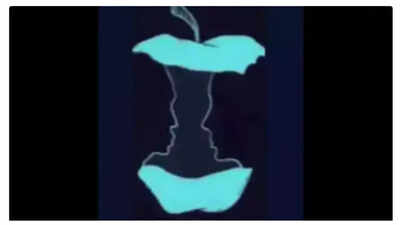Optical illusions are more than just entertaining brain teasers; they offer insights into how our minds work. These visual puzzles challenge our perception and can reveal surprising aspects of our personality.
Optical illusions occur when our brain misinterprets the information our eyes send. This happens because the brain tries to make sense of the visual input, sometimes filling in gaps or making assumptions that aren't accurate. This can lead us to see things that aren't really there or to perceive objects in a distorted way.
Let's explore a classic optical illusion that has been making rounds on social media, shared by user Marina Winberg.

Do you see an eaten apple core, or do you see two faces looking at each other? Your initial perception may reveal a hidden aspect of your personality.
According to Marina Winberg, "This image is a classic dual-illusion where you can either see two faces (a man and a woman) looking at each other OR an apple core—what you notice first says a lot about your mindset!”
If you see the two faces first: Marina suggests this indicates you are a "logical, analytical thinker with strong morals." You value stability, think before you act and approach problems creatively. However, curiosity may sometimes get the better of you.
If you see the apple core first: Seeing the apple core first suggests you are "intuitive, emotionally aware, and great at reading subtle cues." You are good at knowing what to say, but prefer to stay quiet, and also value and protect what’s important to you.
There are three primary categories of optical illusions:
Literal Illusions: These illusions occur when the brain pieces together elements of an image to create a perception that isn't actually present. The two faces or a vase is a classic example.
Physiological Illusions: These illusions result from overstimulation of the visual system. For example, prolonged exposure to bright light, movement, or color can lead to afterimages or the perception of motion in a static image.
Cognitive Illusions: These illusions tap into the brain's subconscious interpretations of information. The Müller-Lyer illusion, where lines appear to be different lengths based on the arrowheads at their ends, is a prime example.
Newer articles
Older articles
 Bangladesh Test Captain Najmul Hossain Shanto Resigns After Sri Lanka Series Defeat
Bangladesh Test Captain Najmul Hossain Shanto Resigns After Sri Lanka Series Defeat
 SA20 Auction: Teams Can Retain Up to Six Players as Salary Cap Jumps to $2.3 Million
SA20 Auction: Teams Can Retain Up to Six Players as Salary Cap Jumps to $2.3 Million
 Android Users Urged to Patch Now: Critical Security Flaws Expose Devices to Attacks
Android Users Urged to Patch Now: Critical Security Flaws Expose Devices to Attacks
 X Cracks Down: Over Half a Million Accounts Suspended in India for Policy Breaches
X Cracks Down: Over Half a Million Accounts Suspended in India for Policy Breaches
 What Your Phone Grip Says About You: A Personality Test
What Your Phone Grip Says About You: A Personality Test
 India's Squad Trimmed: Pacer Released Ahead of Second Test Against England in Birmingham
India's Squad Trimmed: Pacer Released Ahead of Second Test Against England in Birmingham
 Vegetarian Power: 20 Plant-Based Protein Sources That Outperform Eggs
Vegetarian Power: 20 Plant-Based Protein Sources That Outperform Eggs
 ICC Test Rankings: Pant Hits Career High, Bumrah Stays on Top, Root Leads Batters
ICC Test Rankings: Pant Hits Career High, Bumrah Stays on Top, Root Leads Batters
 Rishabh Pant Redefining Cricket: Greg Chappell Hails Wicketkeeper-Batter's Revolutionary Impact
Rishabh Pant Redefining Cricket: Greg Chappell Hails Wicketkeeper-Batter's Revolutionary Impact
 India's Fielding Woes and Top Order Collapse Blamed for First Test Defeat Against England: Former Selector Weighs In
India's Fielding Woes and Top Order Collapse Blamed for First Test Defeat Against England: Former Selector Weighs In